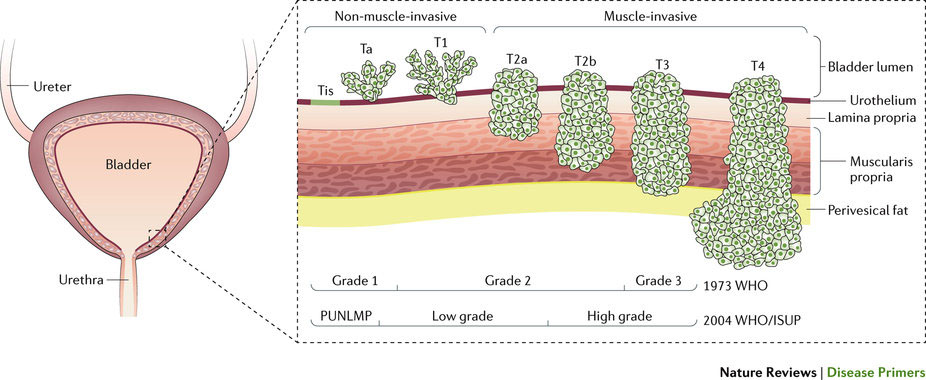膀胱がん
Bladder cancer
2017年4月13日 Nature Reviews Disease Primers Article number: 17022 (2017) doi: 10.1038/nrdp.2017.22

膀胱がんは有病率だけでなく、罹患率や死亡率が高い上に、医療費の負担も大きい。発がん物質の環境曝露または職業曝露、特に喫煙は膀胱がんの主要なリスク因子である。膀胱がんのほとんどは肉眼的血尿により診断され、治療の第1段階としても行われる経尿道的膀胱腫瘍切除術(TURBT)によって確定される。膀胱がんの発症経路には2通りあり、筋層非浸潤性乳頭状腫瘍と筋層浸潤性非乳頭状(固形)腫瘍が発現する。この2つのサブタイプは病理学的特徴だけでなく、分子的性質も異なっている。実際、The Cancer Genome Atlasプロジェクトでは、筋層浸潤膀胱がん(MIBC)のサブタイプごとに、その特徴や治療反応性に加えてドライバー遺伝子が異なることが同定されている。筋層非浸潤性膀胱がん(NMIBC)では、初回のTURBTを施行した後、再発と進行の予防を目的としたBCG維持注入療法が治療の中心になる。BCGに反応性を示さない症例では追加治療が必要となる。局所性MIBCの治療の主な目的は、膀胱切除術後のケアの最適化と罹患率の低減である。転移性がんの治療では、膀胱がんに対するわれわれの遺伝的理解の深化と免疫療法の進展を応用した新たな方法が開発されている。
PrimeView
膀胱がんは血尿の出現後に膀胱鏡検査で診断されることが多い。このPrimeViewではこのよく見られるがんに関する主な事柄について取りまとめる。
本Primerの図解サマリー
Bladder cancer is a highly prevalent disease and is associated with substantial morbidity, mortality and cost. Environmental or occupational exposures to carcinogens, especially tobacco, are the main risk factors for bladder cancer. Most bladder cancers are diagnosed after patients present with macroscopic haematuria, and cases are confirmed after transurethral resection of bladder tumour (TURBT), which also serves as the first stage of treatment. Bladder cancer develops via two distinct pathways, giving rise to non-muscle-invasive papillary tumours and non-papillary (solid) muscle-invasive tumours. The two subtypes have unique pathological features and different molecular characteristics. Indeed, The Cancer Genome Atlas project identified genetic drivers of muscle-invasive bladder cancer (MIBC) as well as subtypes of MIBC with distinct characteristics and therapeutic responses. For non-muscle-invasive bladder cancer (NMIBC), intravesical therapies (primarily Bacillus Calmette–Guérin (BCG)) with maintenance are the main treatments to prevent recurrence and progression after initial TURBT; additional therapies are needed for those who do not respond to BCG. For localized MIBC, optimizing care and reducing morbidity following cystectomy are important goals. In metastatic disease, advances in our genetic understanding of bladder cancer and in immunotherapy are being translated into new therapies.

